PROJ6000 Principles of Project Management: Project Selection Report
VerifiedAdded on 2022/09/06
|10
|2082
|18
Report
AI Summary
This report delves into the intricacies of project selection methods and project initiation documents, using the Singular Logic case study as a framework. It begins by defining project management and its significance, followed by an overview of the case study's context. The core of the report focuses on identifying and justifying suitable project selection methods, categorizing them into quantitative and qualitative approaches. The report then discusses the procedures involved in completing these methodologies, emphasizing the importance of analyzing project opportunities for informed investment decisions. Furthermore, it outlines the essential project initiation documents, including project risk management, project cost management, and project scheduling management, highlighting their critical roles in ensuring project success. The report concludes by summarizing the key components of project management, such as time, cost, and quality, and their relevance in achieving project goals. This report serves as a comprehensive guide to understanding the practical application of project management principles, offering valuable insights for students and professionals alike.

Running head: SINGULAR LOGIC CASE STUDY
Project Selection Method and Project Initiation Document
Student’s Name
University’s Name
Author’s Note:
Project Selection Method and Project Initiation Document
Student’s Name
University’s Name
Author’s Note:
Paraphrase This Document
Need a fresh take? Get an instant paraphrase of this document with our AI Paraphraser
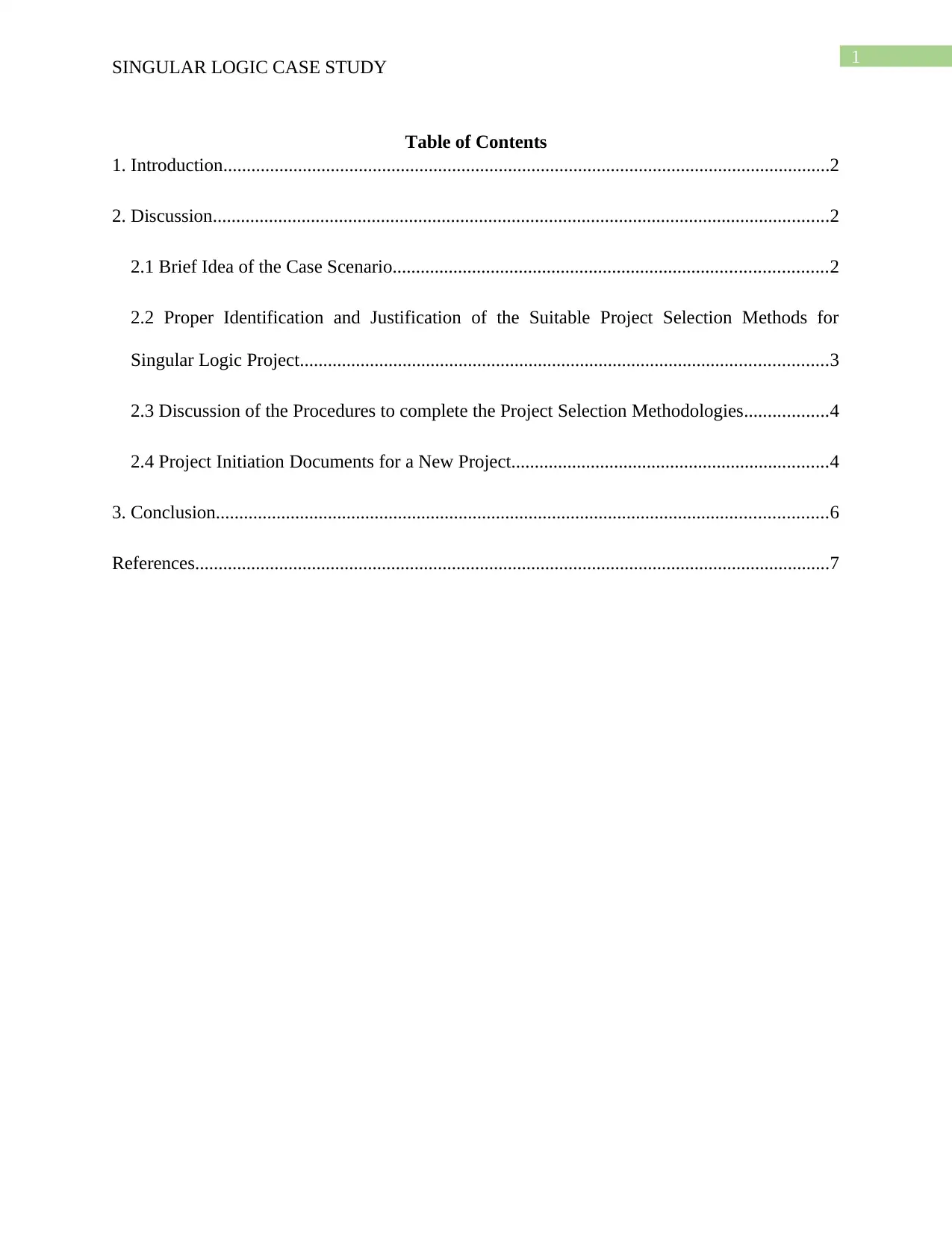
1
SINGULAR LOGIC CASE STUDY
Table of Contents
1. Introduction..................................................................................................................................2
2. Discussion....................................................................................................................................2
2.1 Brief Idea of the Case Scenario.............................................................................................2
2.2 Proper Identification and Justification of the Suitable Project Selection Methods for
Singular Logic Project.................................................................................................................3
2.3 Discussion of the Procedures to complete the Project Selection Methodologies..................4
2.4 Project Initiation Documents for a New Project....................................................................4
3. Conclusion...................................................................................................................................6
References........................................................................................................................................7
SINGULAR LOGIC CASE STUDY
Table of Contents
1. Introduction..................................................................................................................................2
2. Discussion....................................................................................................................................2
2.1 Brief Idea of the Case Scenario.............................................................................................2
2.2 Proper Identification and Justification of the Suitable Project Selection Methods for
Singular Logic Project.................................................................................................................3
2.3 Discussion of the Procedures to complete the Project Selection Methodologies..................4
2.4 Project Initiation Documents for a New Project....................................................................4
3. Conclusion...................................................................................................................................6
References........................................................................................................................................7
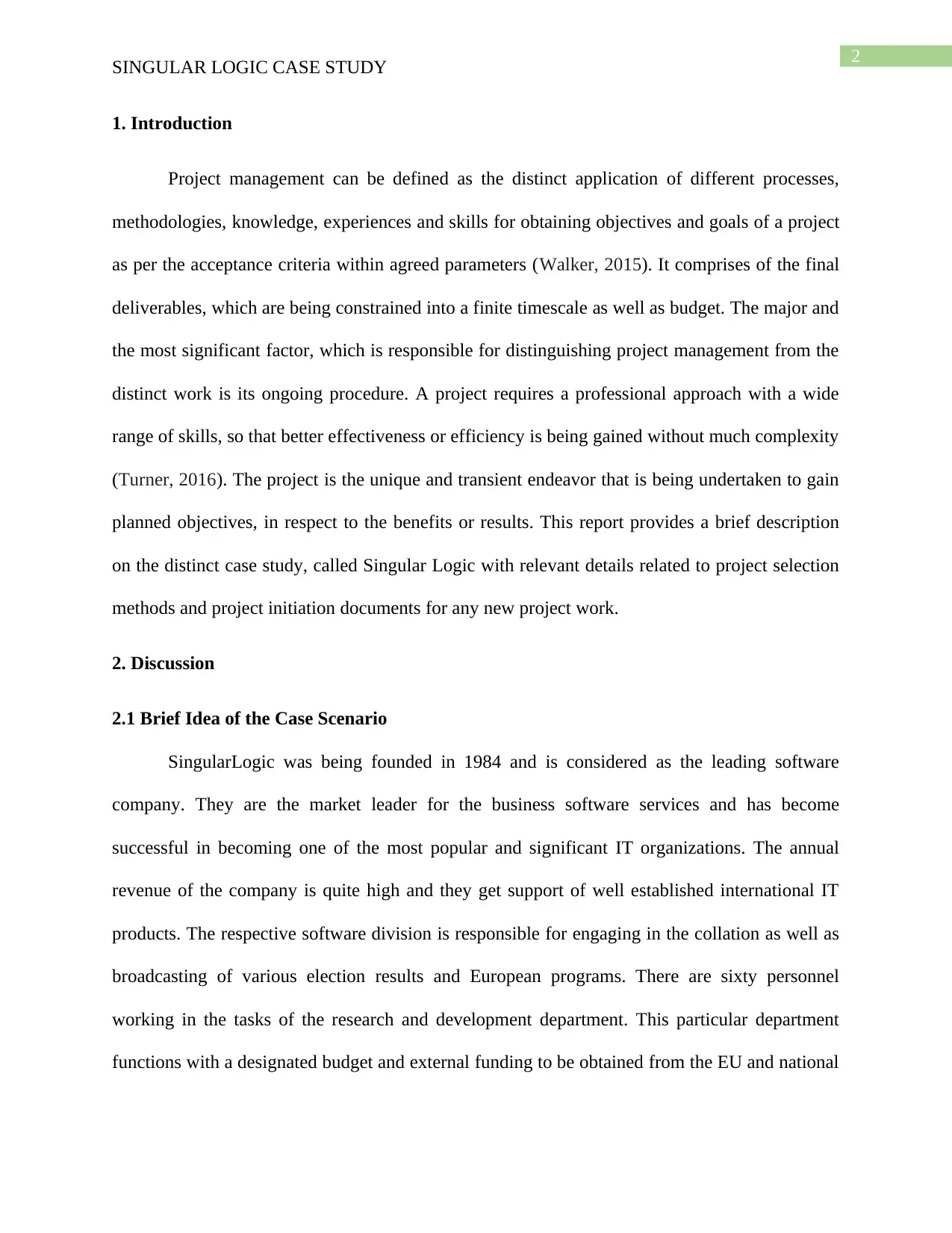
2
SINGULAR LOGIC CASE STUDY
1. Introduction
Project management can be defined as the distinct application of different processes,
methodologies, knowledge, experiences and skills for obtaining objectives and goals of a project
as per the acceptance criteria within agreed parameters (Walker, 2015). It comprises of the final
deliverables, which are being constrained into a finite timescale as well as budget. The major and
the most significant factor, which is responsible for distinguishing project management from the
distinct work is its ongoing procedure. A project requires a professional approach with a wide
range of skills, so that better effectiveness or efficiency is being gained without much complexity
(Turner, 2016). The project is the unique and transient endeavor that is being undertaken to gain
planned objectives, in respect to the benefits or results. This report provides a brief description
on the distinct case study, called Singular Logic with relevant details related to project selection
methods and project initiation documents for any new project work.
2. Discussion
2.1 Brief Idea of the Case Scenario
SingularLogic was being founded in 1984 and is considered as the leading software
company. They are the market leader for the business software services and has become
successful in becoming one of the most popular and significant IT organizations. The annual
revenue of the company is quite high and they get support of well established international IT
products. The respective software division is responsible for engaging in the collation as well as
broadcasting of various election results and European programs. There are sixty personnel
working in the tasks of the research and development department. This particular department
functions with a designated budget and external funding to be obtained from the EU and national
SINGULAR LOGIC CASE STUDY
1. Introduction
Project management can be defined as the distinct application of different processes,
methodologies, knowledge, experiences and skills for obtaining objectives and goals of a project
as per the acceptance criteria within agreed parameters (Walker, 2015). It comprises of the final
deliverables, which are being constrained into a finite timescale as well as budget. The major and
the most significant factor, which is responsible for distinguishing project management from the
distinct work is its ongoing procedure. A project requires a professional approach with a wide
range of skills, so that better effectiveness or efficiency is being gained without much complexity
(Turner, 2016). The project is the unique and transient endeavor that is being undertaken to gain
planned objectives, in respect to the benefits or results. This report provides a brief description
on the distinct case study, called Singular Logic with relevant details related to project selection
methods and project initiation documents for any new project work.
2. Discussion
2.1 Brief Idea of the Case Scenario
SingularLogic was being founded in 1984 and is considered as the leading software
company. They are the market leader for the business software services and has become
successful in becoming one of the most popular and significant IT organizations. The annual
revenue of the company is quite high and they get support of well established international IT
products. The respective software division is responsible for engaging in the collation as well as
broadcasting of various election results and European programs. There are sixty personnel
working in the tasks of the research and development department. This particular department
functions with a designated budget and external funding to be obtained from the EU and national
⊘ This is a preview!⊘
Do you want full access?
Subscribe today to unlock all pages.

Trusted by 1+ million students worldwide
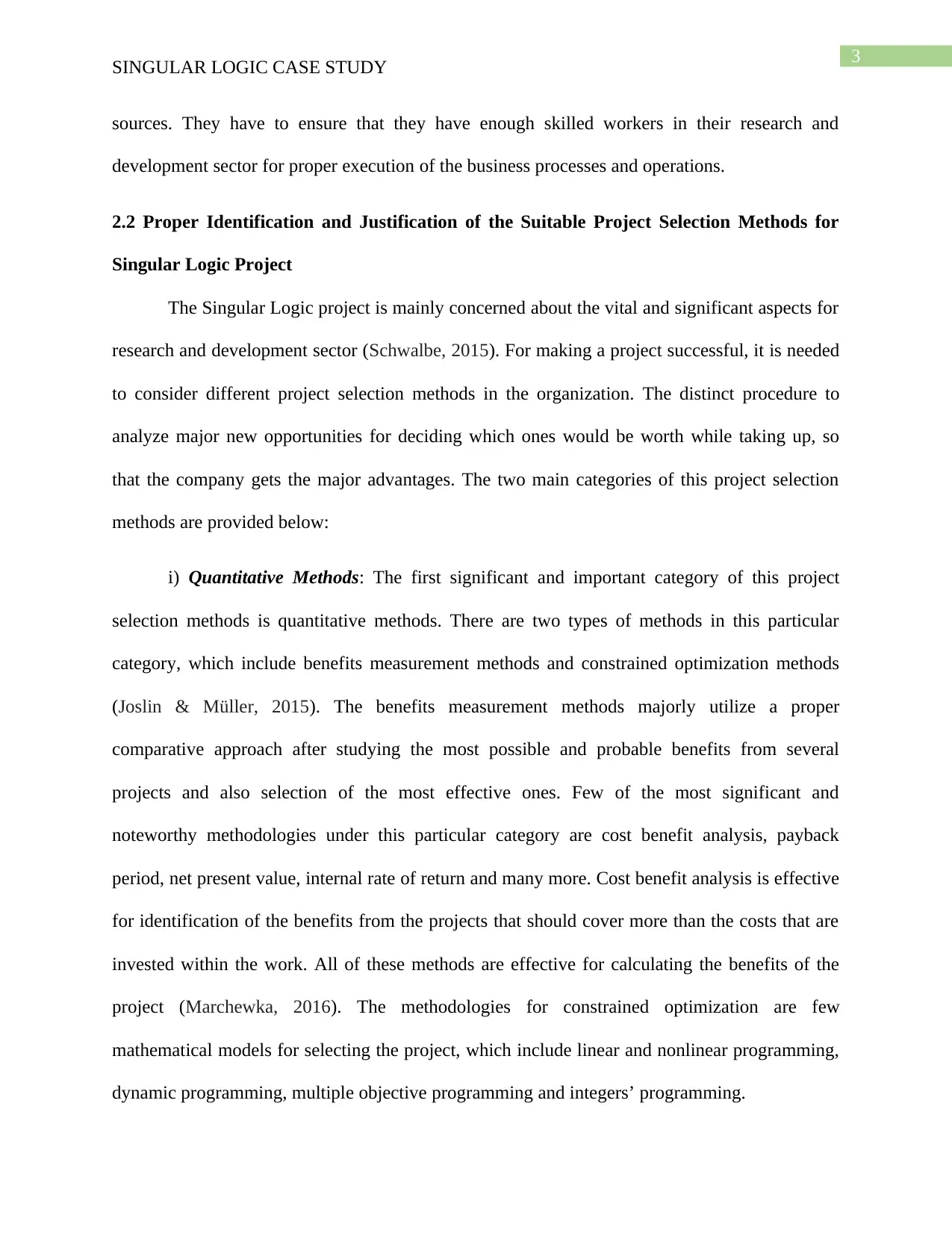
3
SINGULAR LOGIC CASE STUDY
sources. They have to ensure that they have enough skilled workers in their research and
development sector for proper execution of the business processes and operations.
2.2 Proper Identification and Justification of the Suitable Project Selection Methods for
Singular Logic Project
The Singular Logic project is mainly concerned about the vital and significant aspects for
research and development sector (Schwalbe, 2015). For making a project successful, it is needed
to consider different project selection methods in the organization. The distinct procedure to
analyze major new opportunities for deciding which ones would be worth while taking up, so
that the company gets the major advantages. The two main categories of this project selection
methods are provided below:
i) Quantitative Methods: The first significant and important category of this project
selection methods is quantitative methods. There are two types of methods in this particular
category, which include benefits measurement methods and constrained optimization methods
(Joslin & Müller, 2015). The benefits measurement methods majorly utilize a proper
comparative approach after studying the most possible and probable benefits from several
projects and also selection of the most effective ones. Few of the most significant and
noteworthy methodologies under this particular category are cost benefit analysis, payback
period, net present value, internal rate of return and many more. Cost benefit analysis is effective
for identification of the benefits from the projects that should cover more than the costs that are
invested within the work. All of these methods are effective for calculating the benefits of the
project (Marchewka, 2016). The methodologies for constrained optimization are few
mathematical models for selecting the project, which include linear and nonlinear programming,
dynamic programming, multiple objective programming and integers’ programming.
SINGULAR LOGIC CASE STUDY
sources. They have to ensure that they have enough skilled workers in their research and
development sector for proper execution of the business processes and operations.
2.2 Proper Identification and Justification of the Suitable Project Selection Methods for
Singular Logic Project
The Singular Logic project is mainly concerned about the vital and significant aspects for
research and development sector (Schwalbe, 2015). For making a project successful, it is needed
to consider different project selection methods in the organization. The distinct procedure to
analyze major new opportunities for deciding which ones would be worth while taking up, so
that the company gets the major advantages. The two main categories of this project selection
methods are provided below:
i) Quantitative Methods: The first significant and important category of this project
selection methods is quantitative methods. There are two types of methods in this particular
category, which include benefits measurement methods and constrained optimization methods
(Joslin & Müller, 2015). The benefits measurement methods majorly utilize a proper
comparative approach after studying the most possible and probable benefits from several
projects and also selection of the most effective ones. Few of the most significant and
noteworthy methodologies under this particular category are cost benefit analysis, payback
period, net present value, internal rate of return and many more. Cost benefit analysis is effective
for identification of the benefits from the projects that should cover more than the costs that are
invested within the work. All of these methods are effective for calculating the benefits of the
project (Marchewka, 2016). The methodologies for constrained optimization are few
mathematical models for selecting the project, which include linear and nonlinear programming,
dynamic programming, multiple objective programming and integers’ programming.
Paraphrase This Document
Need a fresh take? Get an instant paraphrase of this document with our AI Paraphraser
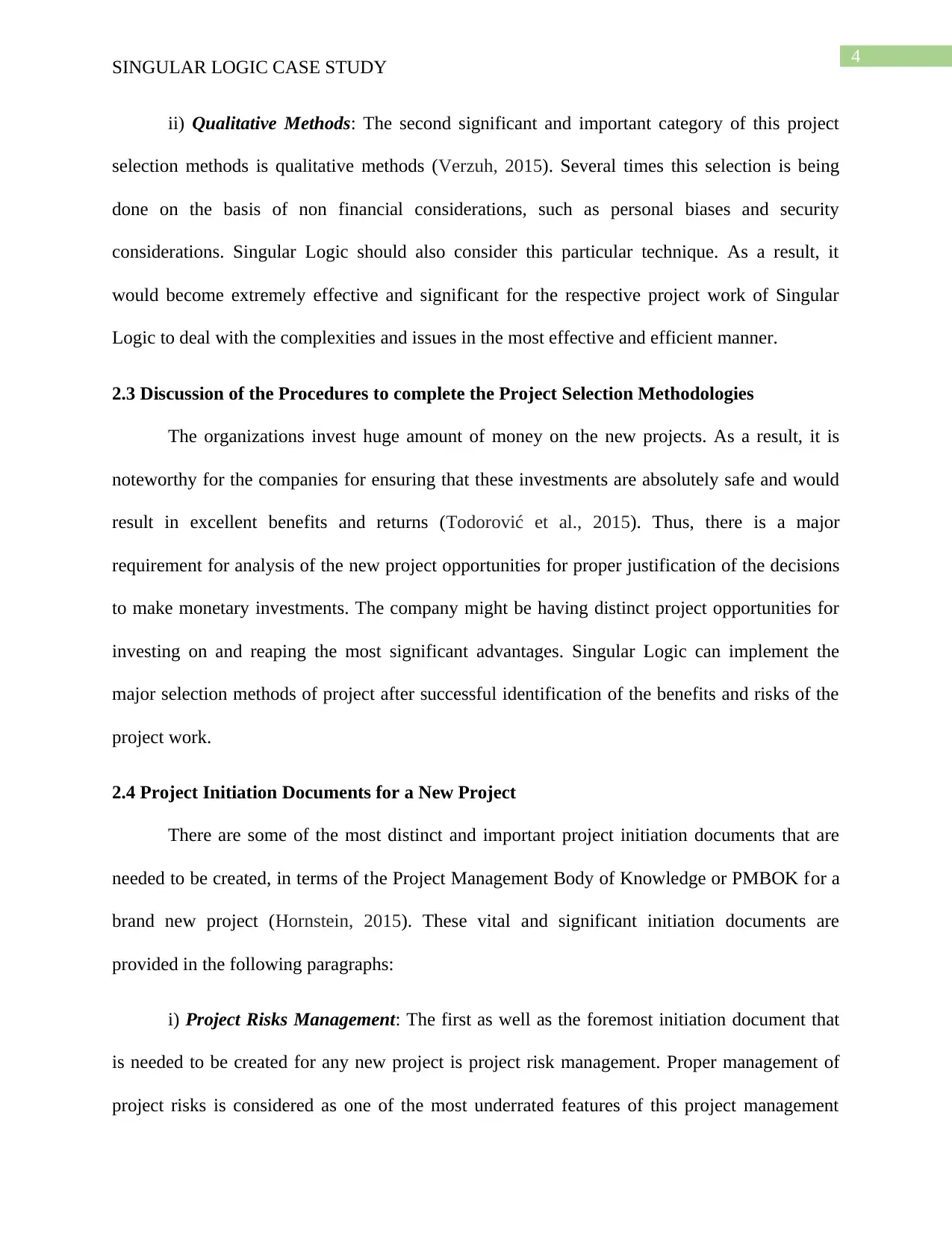
4
SINGULAR LOGIC CASE STUDY
ii) Qualitative Methods: The second significant and important category of this project
selection methods is qualitative methods (Verzuh, 2015). Several times this selection is being
done on the basis of non financial considerations, such as personal biases and security
considerations. Singular Logic should also consider this particular technique. As a result, it
would become extremely effective and significant for the respective project work of Singular
Logic to deal with the complexities and issues in the most effective and efficient manner.
2.3 Discussion of the Procedures to complete the Project Selection Methodologies
The organizations invest huge amount of money on the new projects. As a result, it is
noteworthy for the companies for ensuring that these investments are absolutely safe and would
result in excellent benefits and returns (Todorović et al., 2015). Thus, there is a major
requirement for analysis of the new project opportunities for proper justification of the decisions
to make monetary investments. The company might be having distinct project opportunities for
investing on and reaping the most significant advantages. Singular Logic can implement the
major selection methods of project after successful identification of the benefits and risks of the
project work.
2.4 Project Initiation Documents for a New Project
There are some of the most distinct and important project initiation documents that are
needed to be created, in terms of the Project Management Body of Knowledge or PMBOK for a
brand new project (Hornstein, 2015). These vital and significant initiation documents are
provided in the following paragraphs:
i) Project Risks Management: The first as well as the foremost initiation document that
is needed to be created for any new project is project risk management. Proper management of
project risks is considered as one of the most underrated features of this project management
SINGULAR LOGIC CASE STUDY
ii) Qualitative Methods: The second significant and important category of this project
selection methods is qualitative methods (Verzuh, 2015). Several times this selection is being
done on the basis of non financial considerations, such as personal biases and security
considerations. Singular Logic should also consider this particular technique. As a result, it
would become extremely effective and significant for the respective project work of Singular
Logic to deal with the complexities and issues in the most effective and efficient manner.
2.3 Discussion of the Procedures to complete the Project Selection Methodologies
The organizations invest huge amount of money on the new projects. As a result, it is
noteworthy for the companies for ensuring that these investments are absolutely safe and would
result in excellent benefits and returns (Todorović et al., 2015). Thus, there is a major
requirement for analysis of the new project opportunities for proper justification of the decisions
to make monetary investments. The company might be having distinct project opportunities for
investing on and reaping the most significant advantages. Singular Logic can implement the
major selection methods of project after successful identification of the benefits and risks of the
project work.
2.4 Project Initiation Documents for a New Project
There are some of the most distinct and important project initiation documents that are
needed to be created, in terms of the Project Management Body of Knowledge or PMBOK for a
brand new project (Hornstein, 2015). These vital and significant initiation documents are
provided in the following paragraphs:
i) Project Risks Management: The first as well as the foremost initiation document that
is needed to be created for any new project is project risk management. Proper management of
project risks is considered as one of the most underrated features of this project management
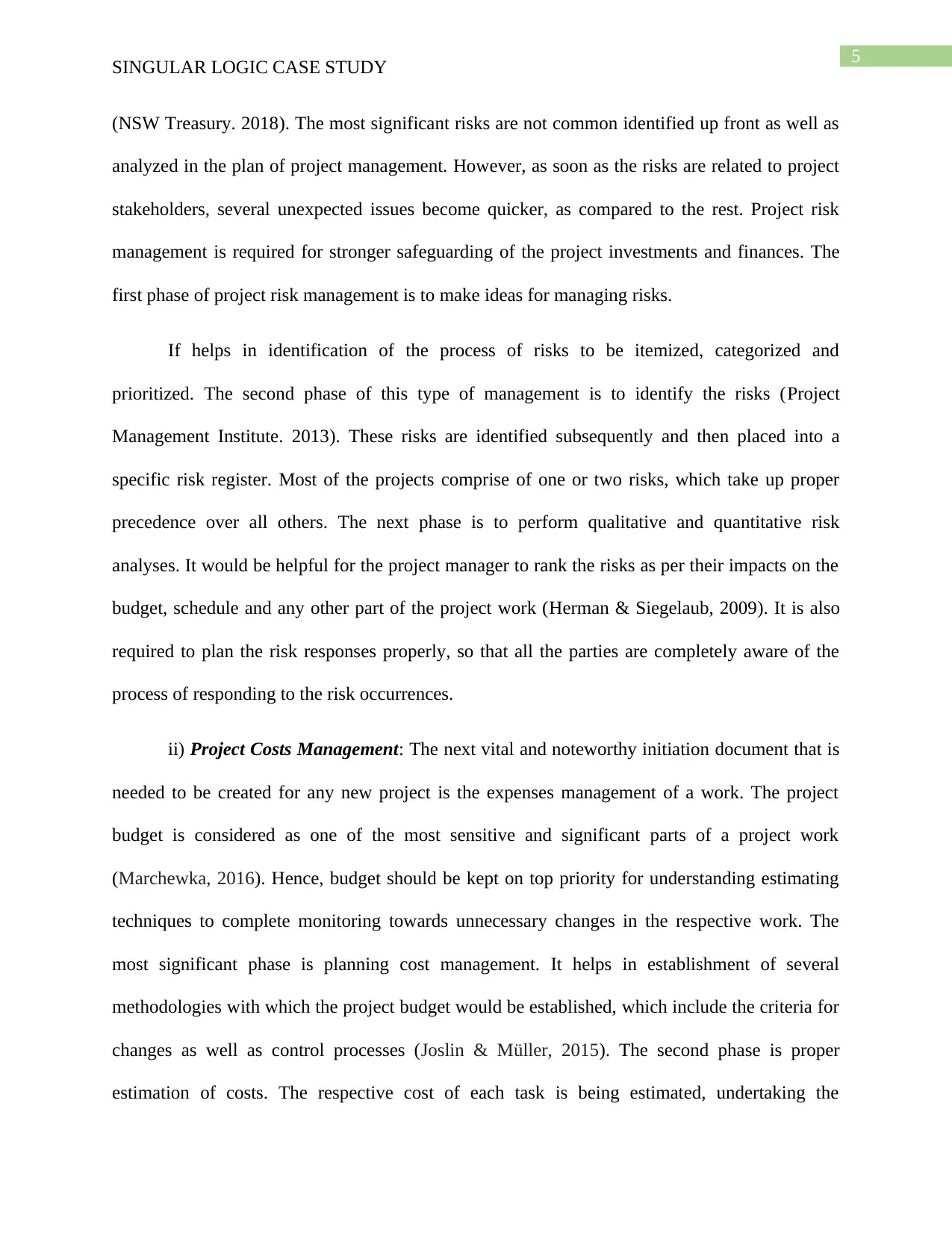
5
SINGULAR LOGIC CASE STUDY
(NSW Treasury. 2018). The most significant risks are not common identified up front as well as
analyzed in the plan of project management. However, as soon as the risks are related to project
stakeholders, several unexpected issues become quicker, as compared to the rest. Project risk
management is required for stronger safeguarding of the project investments and finances. The
first phase of project risk management is to make ideas for managing risks.
If helps in identification of the process of risks to be itemized, categorized and
prioritized. The second phase of this type of management is to identify the risks (Project
Management Institute. 2013). These risks are identified subsequently and then placed into a
specific risk register. Most of the projects comprise of one or two risks, which take up proper
precedence over all others. The next phase is to perform qualitative and quantitative risk
analyses. It would be helpful for the project manager to rank the risks as per their impacts on the
budget, schedule and any other part of the project work (Herman & Siegelaub, 2009). It is also
required to plan the risk responses properly, so that all the parties are completely aware of the
process of responding to the risk occurrences.
ii) Project Costs Management: The next vital and noteworthy initiation document that is
needed to be created for any new project is the expenses management of a work. The project
budget is considered as one of the most sensitive and significant parts of a project work
(Marchewka, 2016). Hence, budget should be kept on top priority for understanding estimating
techniques to complete monitoring towards unnecessary changes in the respective work. The
most significant phase is planning cost management. It helps in establishment of several
methodologies with which the project budget would be established, which include the criteria for
changes as well as control processes (Joslin & Müller, 2015). The second phase is proper
estimation of costs. The respective cost of each task is being estimated, undertaking the
SINGULAR LOGIC CASE STUDY
(NSW Treasury. 2018). The most significant risks are not common identified up front as well as
analyzed in the plan of project management. However, as soon as the risks are related to project
stakeholders, several unexpected issues become quicker, as compared to the rest. Project risk
management is required for stronger safeguarding of the project investments and finances. The
first phase of project risk management is to make ideas for managing risks.
If helps in identification of the process of risks to be itemized, categorized and
prioritized. The second phase of this type of management is to identify the risks (Project
Management Institute. 2013). These risks are identified subsequently and then placed into a
specific risk register. Most of the projects comprise of one or two risks, which take up proper
precedence over all others. The next phase is to perform qualitative and quantitative risk
analyses. It would be helpful for the project manager to rank the risks as per their impacts on the
budget, schedule and any other part of the project work (Herman & Siegelaub, 2009). It is also
required to plan the risk responses properly, so that all the parties are completely aware of the
process of responding to the risk occurrences.
ii) Project Costs Management: The next vital and noteworthy initiation document that is
needed to be created for any new project is the expenses management of a work. The project
budget is considered as one of the most sensitive and significant parts of a project work
(Marchewka, 2016). Hence, budget should be kept on top priority for understanding estimating
techniques to complete monitoring towards unnecessary changes in the respective work. The
most significant phase is planning cost management. It helps in establishment of several
methodologies with which the project budget would be established, which include the criteria for
changes as well as control processes (Joslin & Müller, 2015). The second phase is proper
estimation of costs. The respective cost of each task is being estimated, undertaking the
⊘ This is a preview!⊘
Do you want full access?
Subscribe today to unlock all pages.

Trusted by 1+ million students worldwide
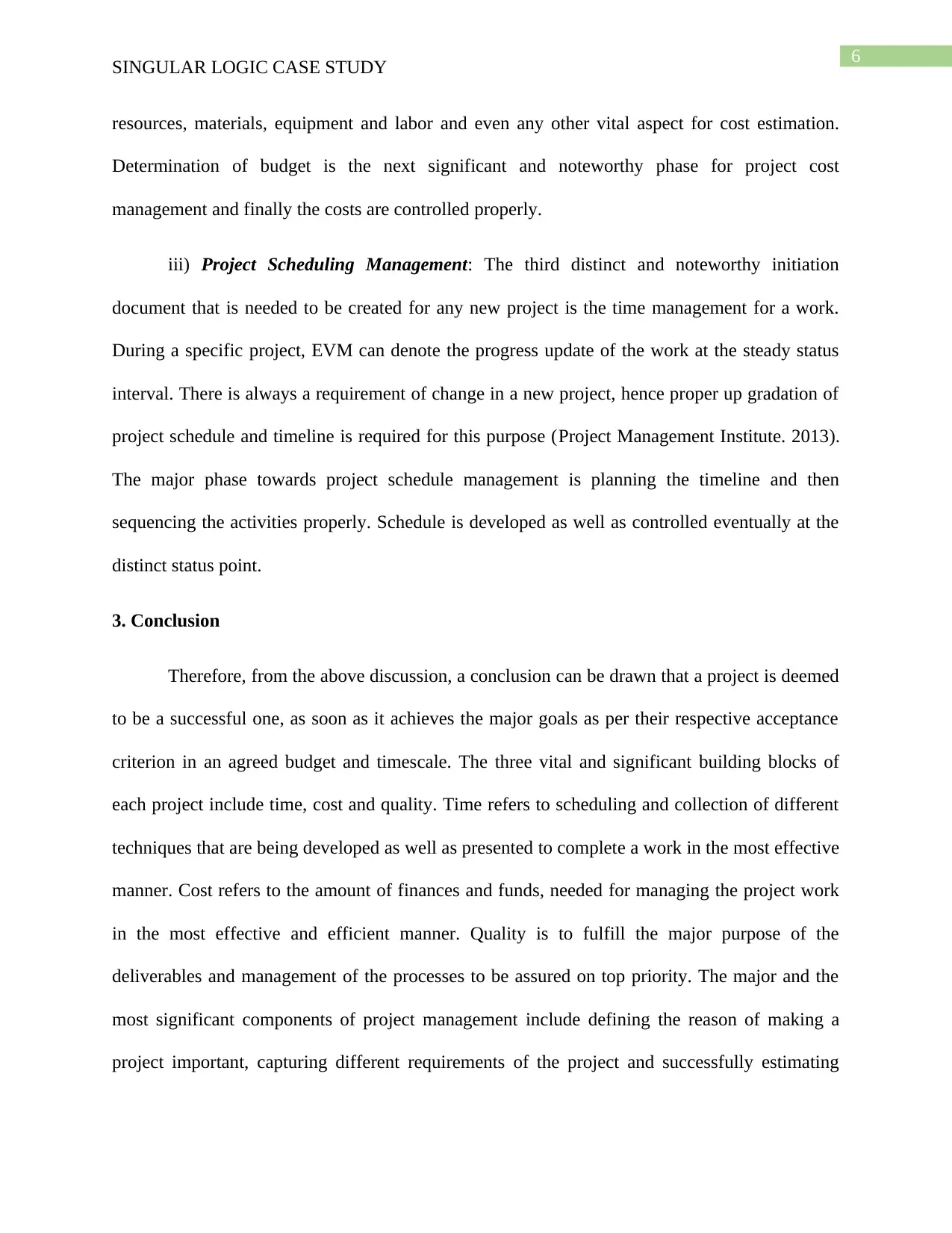
6
SINGULAR LOGIC CASE STUDY
resources, materials, equipment and labor and even any other vital aspect for cost estimation.
Determination of budget is the next significant and noteworthy phase for project cost
management and finally the costs are controlled properly.
iii) Project Scheduling Management: The third distinct and noteworthy initiation
document that is needed to be created for any new project is the time management for a work.
During a specific project, EVM can denote the progress update of the work at the steady status
interval. There is always a requirement of change in a new project, hence proper up gradation of
project schedule and timeline is required for this purpose (Project Management Institute. 2013).
The major phase towards project schedule management is planning the timeline and then
sequencing the activities properly. Schedule is developed as well as controlled eventually at the
distinct status point.
3. Conclusion
Therefore, from the above discussion, a conclusion can be drawn that a project is deemed
to be a successful one, as soon as it achieves the major goals as per their respective acceptance
criterion in an agreed budget and timescale. The three vital and significant building blocks of
each project include time, cost and quality. Time refers to scheduling and collection of different
techniques that are being developed as well as presented to complete a work in the most effective
manner. Cost refers to the amount of finances and funds, needed for managing the project work
in the most effective and efficient manner. Quality is to fulfill the major purpose of the
deliverables and management of the processes to be assured on top priority. The major and the
most significant components of project management include defining the reason of making a
project important, capturing different requirements of the project and successfully estimating
SINGULAR LOGIC CASE STUDY
resources, materials, equipment and labor and even any other vital aspect for cost estimation.
Determination of budget is the next significant and noteworthy phase for project cost
management and finally the costs are controlled properly.
iii) Project Scheduling Management: The third distinct and noteworthy initiation
document that is needed to be created for any new project is the time management for a work.
During a specific project, EVM can denote the progress update of the work at the steady status
interval. There is always a requirement of change in a new project, hence proper up gradation of
project schedule and timeline is required for this purpose (Project Management Institute. 2013).
The major phase towards project schedule management is planning the timeline and then
sequencing the activities properly. Schedule is developed as well as controlled eventually at the
distinct status point.
3. Conclusion
Therefore, from the above discussion, a conclusion can be drawn that a project is deemed
to be a successful one, as soon as it achieves the major goals as per their respective acceptance
criterion in an agreed budget and timescale. The three vital and significant building blocks of
each project include time, cost and quality. Time refers to scheduling and collection of different
techniques that are being developed as well as presented to complete a work in the most effective
manner. Cost refers to the amount of finances and funds, needed for managing the project work
in the most effective and efficient manner. Quality is to fulfill the major purpose of the
deliverables and management of the processes to be assured on top priority. The major and the
most significant components of project management include defining the reason of making a
project important, capturing different requirements of the project and successfully estimating
Paraphrase This Document
Need a fresh take? Get an instant paraphrase of this document with our AI Paraphraser

7
SINGULAR LOGIC CASE STUDY
resources and timescales. The above provided report has clearly outlined a detailed analysis of
the case study of Singular Logic with proper details.
SINGULAR LOGIC CASE STUDY
resources and timescales. The above provided report has clearly outlined a detailed analysis of
the case study of Singular Logic with proper details.

8
SINGULAR LOGIC CASE STUDY
References
Herman, B. & Siegelaub, J. (2009). Is this really worth the effort?: The need for a business case.
Retrieved from https://www.pmi.org/learning/library/need-business-case-6730
Hornstein, H. A. (2015). The integration of project management and organizational change
management is now a necessity. International Journal of Project Management, 33(2),
291-298.
Joslin, R., & Müller, R. (2015). Relationships between a project management methodology and
project success in different project governance contexts. International journal of project
management, 33(6), 1377-1392.
Marchewka, J. T. (2016). Information technology project management: Providing measurable
organizational value. John Wiley & Sons.
NSW Treasury. (2018). NSW Government Business Case Guidelines. Retrieved from
https://www.treasury.nsw.gov.au/sites/default/files/2018-08/TPP18-06%20%20NSW
%20Government%20Business%20Case%20Guidelines.pdf
Project Management Institute. (2013). A guide to the project management body of knowledge
(PMBOK guide) (5th ed.). Newtown Square, PA: PMI.
Schwalbe, K. (2015). Information technology project management. Cengage Learning.
Todorović, M. L., Petrović, D. Č., Mihić, M. M., Obradović, V. L., & Bushuyev, S. D. (2015).
Project success analysis framework: A knowledge-based approach in project
management. International Journal of Project Management, 33(4), 772-783.
Turner, R. (2016). Gower handbook of project management. Routledge.
SINGULAR LOGIC CASE STUDY
References
Herman, B. & Siegelaub, J. (2009). Is this really worth the effort?: The need for a business case.
Retrieved from https://www.pmi.org/learning/library/need-business-case-6730
Hornstein, H. A. (2015). The integration of project management and organizational change
management is now a necessity. International Journal of Project Management, 33(2),
291-298.
Joslin, R., & Müller, R. (2015). Relationships between a project management methodology and
project success in different project governance contexts. International journal of project
management, 33(6), 1377-1392.
Marchewka, J. T. (2016). Information technology project management: Providing measurable
organizational value. John Wiley & Sons.
NSW Treasury. (2018). NSW Government Business Case Guidelines. Retrieved from
https://www.treasury.nsw.gov.au/sites/default/files/2018-08/TPP18-06%20%20NSW
%20Government%20Business%20Case%20Guidelines.pdf
Project Management Institute. (2013). A guide to the project management body of knowledge
(PMBOK guide) (5th ed.). Newtown Square, PA: PMI.
Schwalbe, K. (2015). Information technology project management. Cengage Learning.
Todorović, M. L., Petrović, D. Č., Mihić, M. M., Obradović, V. L., & Bushuyev, S. D. (2015).
Project success analysis framework: A knowledge-based approach in project
management. International Journal of Project Management, 33(4), 772-783.
Turner, R. (2016). Gower handbook of project management. Routledge.
⊘ This is a preview!⊘
Do you want full access?
Subscribe today to unlock all pages.

Trusted by 1+ million students worldwide

9
SINGULAR LOGIC CASE STUDY
Verzuh, E. (2015). The fast forward MBA in project management. John Wiley & Sons.
Walker, A. (2015). Project management in construction. John Wiley & Sons.
SINGULAR LOGIC CASE STUDY
Verzuh, E. (2015). The fast forward MBA in project management. John Wiley & Sons.
Walker, A. (2015). Project management in construction. John Wiley & Sons.
1 out of 10
Related Documents
Your All-in-One AI-Powered Toolkit for Academic Success.
+13062052269
info@desklib.com
Available 24*7 on WhatsApp / Email
![[object Object]](/_next/static/media/star-bottom.7253800d.svg)
Unlock your academic potential
Copyright © 2020–2025 A2Z Services. All Rights Reserved. Developed and managed by ZUCOL.





